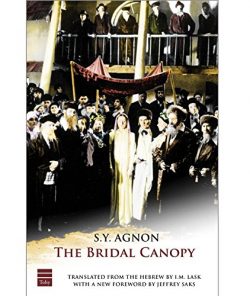The Bridal Canopy
The Bridal Canopy, Nobel laureate S.Y. Agnon’s mock epic novel, is an elaborate frame story encompassing dozens of Hassidic tales. Set in early nineteenth-century Galicia, the plot is part quest, part comedy of errors, progressively departing from its opening tone of realism. It is the tale of poor Reb Yudel of Brody (in today’s western Ukraine, about 100 miles north of Agnon’s native Buczacz), his long-suffering wife, Frummet, and their three modest and righteous daughters, each in need of a bridegroom. The narrative is decisively double-edged: naïve, in the manner of classic folk tales, as well as sophisticated and artful, as a modern work. The Bridal Canopy parodies the Hassidic folk tale, but does so very delicately; it censures without acrimony, always maintaining an air of reverence for the Old World. Unlike other depictions of Eastern European Jewry’s shtetl life, the story is sufficiently subtle to support divergent readings – and that is clearly part of Agnon’s accomplishment. Other Hebrew- or Yiddish-language authors who portray this period level their criticism much closer to the surface.Reality and legend stand side by side in [S.Y. Agnon’s] narrative art. The Bridal Canopy is one of his most characteristic stories, in its ingenious and earthy humor, a Jewish counterpart to Don Quixote and Till Eulenspiegel. Agnon is a realist, but there is always a mystical admixture which lends to even the greyest and most ordinary scenes a golden atmosphere of strange fairy-tale poetry, often reminiscent of Chagall’s motifs from the world of the Old Testament. He stands out as a highly original writer, endowed with remarkable gifts of humor and wisdom, and with a perspicacious play of thought combined with naive perception – in all, a consummate expression of the Jewish character.



























One of Agnon’s greatest novels You really should read this book and enjoy those jokes only the wiseman that is fluent in Aramaic and also studied for decades can understand fully. S. Y. Agnon was a wiseman in the traditional old world Jewish way : he was relieved to be a writer for it allowed him respite from the tedious, life consuming and marrow draining experience of a huge, maybe bigger than his own dreams, appeal to the only god he knew for to ask him to help his slave the estimated writer himself gain access and…